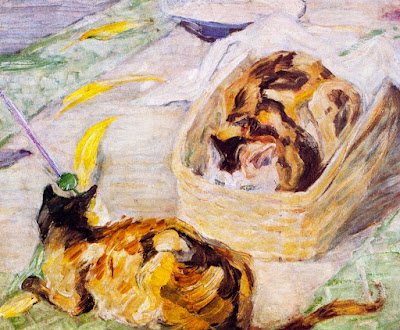a beautiful dwelling: the skull of a dog
I've got a longer than usual excerpt for you today, because to cut it too much would be to blunt the odd beauty of its thoughts. In the following passage, artist and essayist Philip Gilbert Hamilton (1834-1894) writes about the skull of a beloved dog that he keeps close to hand. Though I understand this seems dark to modern sensibilities, the love and respect Hamilton feels for this relic is worth the reading - especially since he grew up an orphan raised by aunts.
* * *
THERE is a little skull amongst the bones I have collected for the study of anatomy, which any slightly scientific person would at once recognise as that of a dog. It is a beautiful little skull, finely developed, and one sees at a glance that the animal, when it was alive, must have possessed more than ordinary intelligence. The scientific lecturer would consider it rather valuable as an illustration of cranial structure in the higher animals; he might compare it with the skull of a crocodile, and deduce conclusions as to the manifest superiority of the canine brain.
To me this beautiful little example of Divine construction may be a teacher of scientific truths, but it is also a great deal more than that. My memory clothes it with mobile muscles and skin, covered with fine, short hair, in patches of white and yellow. Where another sees only hollow sockets in which lurk perpetual shadows, I can see bright eyes wherein the sunshine played long ago, just as it plays in the topaz depths of some clear northern rivulet. I see the ears too, though the skull has none; and the ears listen and the eyes gaze with an infinite love and longing.
She was the friend of my boyhood . . .
Of course the reader cannot be expected to care very much about a poor little terrier that only loved its young master, as all dogs will, by reason of the instinct that is in them, and died more than eighteen years ago. I am willing to believe that millions of dogs have been as good as she was, and a great deal more valuable in the market, but no skull in the best natural history collections in Europe could tempt me to part with this. Every year makes the relic more precious, since every year certain recollections gradually fade, and this helps me to recover them. You may think that it is a questionable taste to keep so ghastly a reminder. It does not seem ghastly to me, but is only as the dried flower that we treasure in some sacred book. When I think by how much devoted affection this bony tenement was once inhabited, it seems to me still a most fair and beautiful dwelling.
* * *
THERE is a little skull amongst the bones I have collected for the study of anatomy, which any slightly scientific person would at once recognise as that of a dog. It is a beautiful little skull, finely developed, and one sees at a glance that the animal, when it was alive, must have possessed more than ordinary intelligence. The scientific lecturer would consider it rather valuable as an illustration of cranial structure in the higher animals; he might compare it with the skull of a crocodile, and deduce conclusions as to the manifest superiority of the canine brain.
To me this beautiful little example of Divine construction may be a teacher of scientific truths, but it is also a great deal more than that. My memory clothes it with mobile muscles and skin, covered with fine, short hair, in patches of white and yellow. Where another sees only hollow sockets in which lurk perpetual shadows, I can see bright eyes wherein the sunshine played long ago, just as it plays in the topaz depths of some clear northern rivulet. I see the ears too, though the skull has none; and the ears listen and the eyes gaze with an infinite love and longing.
She was the friend of my boyhood . . .
Of course the reader cannot be expected to care very much about a poor little terrier that only loved its young master, as all dogs will, by reason of the instinct that is in them, and died more than eighteen years ago. I am willing to believe that millions of dogs have been as good as she was, and a great deal more valuable in the market, but no skull in the best natural history collections in Europe could tempt me to part with this. Every year makes the relic more precious, since every year certain recollections gradually fade, and this helps me to recover them. You may think that it is a questionable taste to keep so ghastly a reminder. It does not seem ghastly to me, but is only as the dried flower that we treasure in some sacred book. When I think by how much devoted affection this bony tenement was once inhabited, it seems to me still a most fair and beautiful dwelling.
* * *
-- Hamerton, Philip Gilbert, 1834-1894. Chapters On Animals. Boston: Roberts brothers, 1893. pp. 17-8.



Comments
Post a Comment